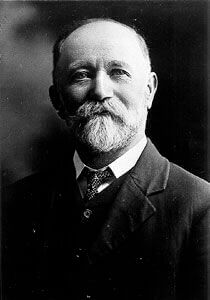Home » Creswick » History » People » W.G. Spence
W.G. Spence
 WILLIAM GUTHRIE SPENCE(1846-1926), trade unionist and politician, was born on 7 August 1846 at the island of Eday, Orkney, Scotland, son of James Maxwell Spence, stonemason, and his wife Jane, née Guthrie. He came to Geelong, Victoria, with his family probably in February 1852. Next year they moved to Spring Hill near Creswick and as a small boy he reputedly observed the Eureka rebellion in 1854, later claiming that he had vivid and formative memories of it. At 13 he was a shepherd at G. Bell and P. McGuiness's station, Corong, in the Wimmera, and in 1861 he was a butcher-boy, and held a miner's right at 14.
WILLIAM GUTHRIE SPENCE(1846-1926), trade unionist and politician, was born on 7 August 1846 at the island of Eday, Orkney, Scotland, son of James Maxwell Spence, stonemason, and his wife Jane, née Guthrie. He came to Geelong, Victoria, with his family probably in February 1852. Next year they moved to Spring Hill near Creswick and as a small boy he reputedly observed the Eureka rebellion in 1854, later claiming that he had vivid and formative memories of it. At 13 he was a shepherd at G. Bell and P. McGuiness's station, Corong, in the Wimmera, and in 1861 he was a butcher-boy, and held a miner's right at 14.
In 1912 he recalled that goldfields life had 'made such a deep impression on my youthful mind that nothing but the grave will efface it'. Spence had no formal schooling but 'at odd moments' was taught by a graduate of Trinity College, Dublin; he read 'in a curiously miscellaneous way' including, as he matured, the works of Bellamy, Blatchford, Ruskin and Morris. He became secretary and Sunday school superintendent for the Creswick Presbyterian Church and in the 1880s often preached with the Primitive Methodists and the Bible Christians. On 20 June 1871 at the Presbyterian manse, Creswick, he married Ann Jane Savage, daughter of William Savage of Londonderry, Northern Ireland.
Spence's mining experience included work as a 'shift boss' and manager. In the Clunes district and in 1874 he initiated an ephemeral trade union that was part of the process of the formation at Bendigo in the same year of the Amalgamated Miners' Association of Victoria. In 1878 as secretary of the Creswick Miners' Union, with John Sampson president, he led 600 men into the A.M.A.: both were later black-balled by the mine-owners. In 1882-91 Spence was general secretary, and under him the association 'was moderate and conciliatory but firm on fundamentals'; he claimed it never refused a conference, but it had twenty-nine strikes before 1890. A superb negotiator, he wanted a union that would cover all kinds of miners in Australia and New Zealand, and from 1884 several unions, including New South Wales coalminers, affiliated loosely and the union became the A.M.A. of Australasia.
Spence co-operated with the Melbourne Trades Hall Council but could not convince his union of the need of political organization, although in 1886 he secured several amendments to the colony's Regulation of Mines and Machinery Act. At the second Intercolonial Trades Union Congress, Melbourne, 1884, he gained unanimous approval for the establishment of an Intercolonial Federal Council of Amalgamated Trades, but nothing came of it. A teetotaller, in Creswick he became a member of the militia and a leading temperance advocate; prominent in the debating society, he was a Borough Councillor from 1884 and a Justice of the Peace from 1888: a recent historian has said of him, 'Genial and quite imperturbable, he stands out as the most remarkable man in the remarkable town of Creswick in the eighties'.
Spence's great repute as an industrial organizer of widely dispersed workers led to his appointment in 1886 as foundation president of the Amalgamated Shearers' Union of Australasia. With great skill and zeal, and against aggressive opposition from many pastoralists, by 1890 he had unionized most shearers in South Australia, Victoria and New South Wales and had gained the 'closed shop' in about 85 per cent of the shearing sheds. With main objectives of recruiting the Queensland shearers and obtaining the complete 'union shed', this work took him for the first time consistently among city unionists; in the late 1880s he encouraged his New South Wales branches to join the Trades and Labor Council in Sydney.
On 17 May 1890 he dominated a conference in Brisbane at which the owners of Jondaryan station recognized the Queensland Shearers' Union in the face of a putative united front of maritime unions which had refused to handle their wool. This victory led Spence to intensify his efforts for maximum unionism in New South Wales and Victoria. In a verbose manifesto of 12 July which put great pressure on non-union pastoralists, he claimed incorrectly that the Wharflabourers' and Seamen's unions had agreed to back his campaign with direct action. His plans excluded strikes by shearers; but he exacerbated inflamed industrial relations in the intercolonial maritime industries, especially in New South Wales and among ships' officers, and helped to precipitate the maritime strike that broke out on 15 August and ended on 2 November 1890 with the workers defeated. Against his vote on the Labor Defence Council the shearers were partially involved in September for one week.
Spence's ineptitude resulted in part from his heavy work load. In September at a critical stage of the strike he gave valuable evidence in Melbourne to the royal commission on gold-mining, but essentially his great success with bushworkers had limited his industrial understanding and enlarged his populist longings. Some of his pastoralist opponents shared his mysticism; they believed their own propaganda that somewhere in the outback 'Spence's station', allegedly acquired by levies on the workers, was the ultimate in luxury and wealth. His unique mixture of inspirational socialism and hard-headed unionism evoked a confused vision of all employees in one big union but produced little understanding of the problems of city workers. He emphasized the primacy of the A.S.U. in Labor political action, and broke with the A.M.A. in Victoria in 1891-92 when it drew up its own programme in opposition to that of the Progressive Political League; in 1892 he ran for the league at the by-election for the seat of Dundas in the Victorian Legislative Assembly but lost narrowly. At the seventh Intercolonial Trades and Labor Congress of Australasia in Ballarat in 1891, he backed the scheme for the Australasian Federation of Labour, which envisaged a firm link between industrial and political organization.
Spence took no part in the determined work of the Trades and Labor Council in Sydney in 1890-91 that produced the Labor Electoral League and spectacular success at the 1891 general elections. More than most of his contemporaries, he was muddled about the connexion between the 'New Unionism' and the old. In Sydney on 12 June 1892 his lecture on 'The Ethics of the New Unionism' (published 1892) confused its relationship with political action, but revealed his own millennialism: 'It is useless', he said, 'to go on preaching from Sabbath to Sabbath asking men to be better but … the New Unionism is to deal with those evils in a practical manner'. In the 1891-93 conflicts in the Labor Party in New South Wales he used the Federation of Labour to oppose the 'solidarities'; when they triumphed in 1894-95 his prospects of assuming a leading political role had evaporated and he was lampooned by the bright young city Labor men, especially William Hollman and Billy Hughes in the radical newspaper the New Order.
Spence's industrial success continued. In 1894 he helped to combine several small bush unions with the A.S.U. and to found the Australian Workers' Union; as its secretary in 1894-98 and president 1898-1917, he saw the union as the industrial wing of the Labor Party. He held the mining-pastoralist seat of Cobar in the New South Wales Legislative Assembly in 1898-1901, but made little impression in parliament though he was accorded the deference merited by past achievement. A supporter of Federation, he pointed to the successful organization of the A.W.U. He was elected to the first Federal parliament in 1901 as member for Darling in far-west New South Wales. In Sydney in 1909, helped by his son-in-law Hector Lamond, he published Australia's Awakening, which stated that the organization of the bushworkers and the 1890 strike marked the foundations of industrial trade unionism in Australia. The book was an effort both to disarm growing opposition in the A.W.U. to his presidency and to defend the union from the Industrial Workers of the World, who were organizing the 'One Big Union'. In 1911 in Sydney he published the History of the A.W.U.; he wrote several pamphlets; he also contributed to and helped to edit the Australian Worker. In the 1900s he worked hard for a Labor daily under the control of the A.W.U.
In 1914-15 Spence was Commonwealth postmaster-general and in 1916-17 vice-president of the Executive Council; as a minister he was 'largely the voice of the permanent heads'. In the Labor Party crisis in 1916-17 he was ill and, according to A.W.U. officials, was tricked by Hughes and Lamond into voting for conscription. He was the one member of the union allowed to resign instead of being expelled for his action. Rejected by the Labor Party he lost his seat in 1917, but at a by-election the same year he won Darwin (Tasmania) as a Nationalist candidate. He ran for Batman (Victoria) in 1919 but lost. He died of pulmonary oedema in his son's home at Terang on 13 December 1926, survived by his wife, four daughters and three of his five sons; buried in Coburg cemetery, he left an estate valued for probate at £1200.

Business & Tourism Creswick Inc.
PO Box 214
Creswick, Victoria, 3363
info@creswick.net




